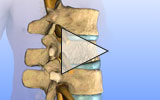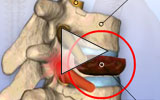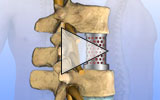Spine Fractures
The spinal column consists of a series of vertebrae (made of bone) attached to each other by discs (made of soft collagen) and stabilized by a complex arrangement of ligaments, muscles and joints. The cervical spine (neck) houses nerves that make up the spinal cord.
When the spinal column experiences enough traumatic force, its bony elements can break (known as a fracture). Vertebrae that have been weakened due to osteoporosis can break even as a result of a low level of trauma. Spinal fractures can cause pain, instability and, in severe cases, paralysis. Whether or not the spine remains stable after such a break will depend upon on the severity of the fracture and the integrity of the spine's stabilizing structures. Unstable spines can be associated with an increased risk of the neurologic (nerve) damage. An unstable cervical spine can be associated with an increased risk of the spinal cord damage and can lead to weakness and dysfunction of the arms and legs.
- Spine anatomy overview
- Spine fracture and back surgery animations
- Articles on diagnosing spine fractures
Spine anatomy overview
The bones that compose the spine (or backbone) are divided into four basic segments. From top to bottom, these are:
- The cervical spine (the neck) – the first seven vertabrae located just below the skull
- The thoracic spine – the 12 vertabrae of the upper back
- The lumbar spine – the five vertabrae of the lower back
- The sacral spine – composed of a triangular structure called the sacrum (five individual vertabrae that fuse together between the age of 18 and 30) and the coccyx (commonly called the tailbone and composed of three to five individual vertabrae, some of which may fuse together in adulthood)

Spinal fracture and back surgery animations
View these video animations for illustrated views of spine vertebrae fractures and surgical treatments options. The surgical animations provide only a general overview of a particular orthopedic procedure. HSS surgeons tailor each operation to the individual patient.
Spinal compression fractures
A traumatic spine fracture can lead to compression of one or more vertebrae and injury to the spinal cord or nerves. Interventional treatment options include kyphoplasty or spinal fusion surgery.
Anterior thoracic vertebral body replacement surgery
An anterior thoracic vertebral body replacement involves the removal and replacement a damaged vertebra, and stabilizes the spine. The surgeon accesses the damaged spine from the front (anterior) of the body. This procedure can reduce painful compression of the spinal cord and nerves, which may result from a trauma where a vertebra is severely fractured, or when pressure created by a tumor that has spread to the front of the spine fractures a vertebra.
Lumbar vertebral body replacement surgery
Spinal fractures involving vertebrae in the lumbar spine (lower back) can cause pressure on the spinal nerves, resulting in pain. Severe fractures are unstable and often require surgery to remove and replace the damaged vertebra (or vertebrae) and stabilize the spine. A lumbar vertebral body replacement involves replacement of the affected vertebrae with a small metal cage filled with bone graft material, which is then screwed into the adjacent healthy vertebrae.
Articles related to spinal fractures
Learn about radiological imaging to diagnose back pain and spinal fractures.
Spine Fractures Success Stories
In the news




